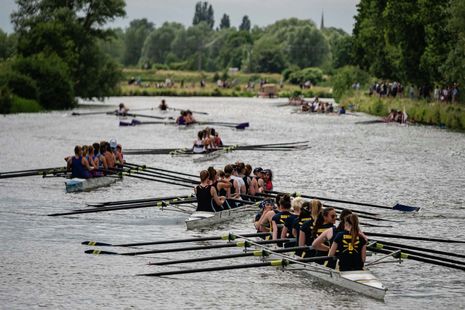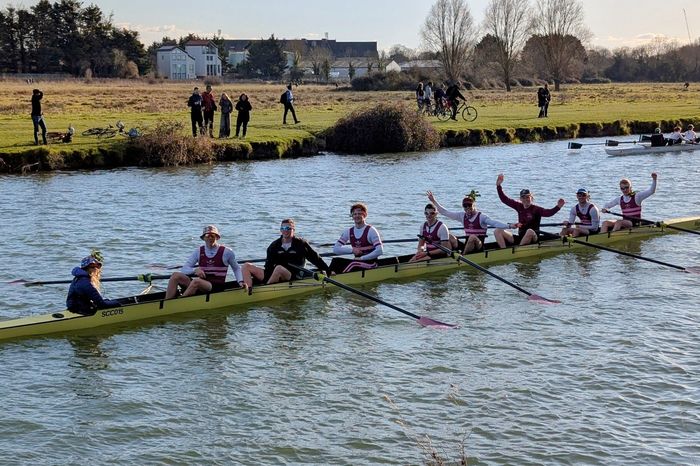Bumping through history
Barney Blackburn looks through the Bumps archives to uncover some of the most intriguing stories to have emerged from its 200-year history

A quintessential part of Cambridge’s sporting calendar, the Lent and May Bumps are raced every year on the river Cam. More than a thousand students take part in the culmination of the college rowing season. With almost two centuries worth of history, myths and legends abound, fact and fiction are often as blurred as a crew hurtling round Grassy Corner – so I’ve delved into the Bumps annals to explore the stories of this classically ‘Cambridge’ competition.
In the Clare College boat club is a blade presented to the club in 2018 by Rosemary Dooley. It commemorates the Cambridge Bumps’ most tragic accident – the death of Edward Campbell in 1888. Almost 140 years ago, the Bumps course bore witness to a freak accident. On the third day of Lents, Clare College’s crew were enjoying a fantastic campaign; bumping up on their first two days, with Queen’s next in their quest for Blades. As the sun glistened down on First Post Reach, Clare brimmed with confidence as they paddled to their starting position. At 4-seat sat 20-year-old Edward Campbell, the engine room of the boat. A storming start saw Campbell and his Clare colleagues catch Queen’s in superb time, securing a bump by First Post Corner.
Racing behind Clare were Trinity Hall, coxed by first–year Edward Jenkins. After being bumped by Clare the previous day, Hall were still struggling, and Jenkings could feel a charging Emmanuel crew hot on his heels. Inexplicably, the coxswain diverted all attention to Emmanuel, fixing his gaze behind him while aiming to create choppy water for the oncoming crew by activating the boat’s rudder. Unbeknownst to Jenkings, the Hall crew had failed to take the corner and were on a collision course with Campbell’s celebrating Clare crew.
“Dr Rygate inspected Campbell, and “pronounced life to be extinct”.”
Careering straight for the bank, Trinity Hall’s boat clattered over Clare’s rigger; its bow lifting Campbell out of the water as he was fatally impaled. Carried straight to the Plough Inn at Fen Ditton, Dr Rygate inspected Campbell, and “pronounced life to be extinct”.
The death was widely reported on, most notably by the Times, and cast a shadow over this great amateur sporting event. An inquisition was duly held. How could such a fatality have occured: was it the fault of the willow stumps that had supposedly obscured Clare’s boat from Jenkins view, as Trinity Hall’s butler claimed, or the searing sunlight? Campbell’s father rejected this notion: Jenkins himself had admitted that his attention had been solely directed towards the Emmanuel boat. Ultimately, Jenkins was not convicted of manslaughter – it was, however, a “very close shave”.
Campbell’s death revolutionised rowing safety – since that fateful day, boats have been fitted with rubbery bow balls; little attachments on the end of the boat to avoid another tragic impaling. Sure, there are still collisions when careless coxes career round the course, but since the invention of bow balls, Campbell remains the only rower to have been killed during the Bumping Races.
“The celebration following the win is generally regarded as the first ever May Ball.”
Unless, of course, you have been seduced by a popular myth. The legend goes that during the Bumps of 1876, St John’s College attached a sword to their bow. Thus, in the process of bumping Trinity College’s boat, the latter’s cox was killed. But is there any truth to this matter?
You’d be right to think that, were this to be correct, there would certainly be coroner’s reports, or newspaper articles detailing such a tragedy. Predictably, there are no official records to support this fantastical claim. After research through the Lady Margaret Boat Club’s (John’s college team) history books , there was, however, a near fatality in 1876 – a small boy darted out onto the water in a canoe and sustained an injury after colliding with a Lady Margaret boat. There was also a key rivalry between Trinity and John’s that year, with LMBC bumping Trinity’s second’s under the willows on day 2. How these stories became conflated, and spiralled out of control to the extent that a sword became involved, I can not decipher. And while proof of the incident is often based upon the fact that Trinity’s second crew dissolved that year, this was merely due to not having enough theologians to make up their exclusively one-tripos club.
Trinity College’s boat club, now known as First and Third, have still had their fair share of escapades on the water. In 1857, a mid–Bumps collision left a Trinity man without an oar. Miraculously, a spare oar was slung his way from the bank, which the bow-man expertly caught, and proceeded to continue rowing, rejoining the rhythm of the rest of his crew. Unbelievably, they achieved the bump by the Plough pub. The celebration following the win is generally regarded as the first ever May Ball.
It’s not just May Balls that Cambridge’s college rowing scene has given rise to. It is Lady Margaret Boat Club’s dashing bright red jackets that can lay claim to being responsible for the origin of the term ‘blazer’. No, they are not red to commemorate the blood shed in the Bumps’ “sword incident”, as some have claimed!
Hostilities still arise between the colleges of Trinity and John’s when it comes to Bumps, however, even without the involvement of medieval weaponry. As the First and Third’s Captain tells me, every day of the Lent’s and May’s the two colleges meet in the early hours for the ‘Stomp’. This ritualised clash, where rival rowers partake in shoulder-barging and a modified version of British Bulldog – amidst the stunning background of Trinity’s Great Court – is a lightly competitive tradition; the real battle is of course played out on the water. Yet porters still lie in wait with first aid equipment if things begin to get a little bit hasty.
Perhaps my favourite story from the Cambridge Bumping Races’ unusually fascinating history belongs to that of a certain R.R. Hall. We return to 1888, where, after a hold-up on the river forced a re-row at a later time, Hall found himself stuck in a bind. With an exam ending at 1pm and proceedings resuming at half past the hour, the collegiate rower would have to move fast to return to his crew. After rushing over to the Pike & Eel pub, he stumbled across a horse, mounting it and galloping down the river. In the nick of time, Hall had hopped back into the LMBC boat and returned for the start of the race.
While being far from glamorous, Bumps perfectly captures the peculiarity of Cambridge tradition. With a never–ending dictionary of jargon, coupled with a history of heroic antics, college rowing’s strange allure is still just as prominent. Just watch out for those crafty Lady Margaret boats: who knows when they will try that ol’ sword trick next.
 News / Uni Scout and Guide Club affirms trans inclusion 12 December 2025
News / Uni Scout and Guide Club affirms trans inclusion 12 December 2025 News / Cambridge Vet School gets lifeline year to stay accredited28 November 2025
News / Cambridge Vet School gets lifeline year to stay accredited28 November 2025 News / Cambridge study finds students learn better with notes than AI13 December 2025
News / Cambridge study finds students learn better with notes than AI13 December 2025 Science / Did your ex trip on King’s Parade? The science behind the ‘ick’12 December 2025
Science / Did your ex trip on King’s Parade? The science behind the ‘ick’12 December 2025 News / Pembroke to convert listed office building into accom9 December 2025
News / Pembroke to convert listed office building into accom9 December 2025








